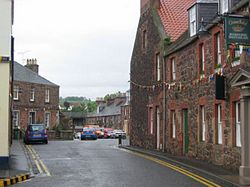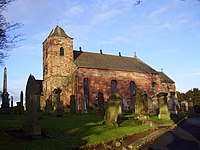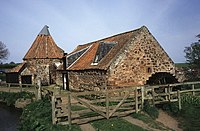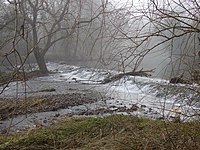East Linton: Difference between revisions
m Pictures |
No edit summary |
||
| (2 intermediate revisions by 2 users not shown) | |||
| Line 16: | Line 16: | ||
'''East Linton''' is a small town in [[East Lothian]], standing on the [[River Tyne, East Lothian|River Tyne]] and the A1 road five miles east of [[Haddington]]. Its recorded 2001 population of 1,774 is a decline from 1,928 recorded in 1881. | '''East Linton''' is a small town in [[East Lothian]], standing on the [[River Tyne, East Lothian|River Tyne]] and the A1 road five miles east of [[Haddington]]. Its recorded 2001 population of 1,774 is a decline from 1,928 recorded in 1881. | ||
The village is not as busy as in the days of the stage coaches which once kept it busy and of the railway which succeeded them, but it remains a pretty village and its historical heritage | The village is not as busy as in the days of the stage coaches which once kept it busy and of the railway which succeeded them, but it remains a pretty village and its historical heritage is shown in the buildings of the village. It also serves as a base for exploring the East Lothian countryside. | ||
A distinctive sight in the middle of the | A distinctive sight in the middle of the village is its fountain. The fountain was built in 1882 and has four little cherubs pouring water out of their vessels into the main fountain, and lights atop. It is kept in working order, standing in front of the former St Andrew's Church. | ||
East Linton probably gets its name from the Linn (a waterfall) on the river next to the village, although Martine adds that it was called '''East''' Linton to distinguish it from West Linton in [[Peeblesshire]] when the railways were built. | East Linton probably gets its name from the Linn (a waterfall) on the river next to the village, although Martine adds that it was called '''East''' Linton to distinguish it from West Linton in [[Peeblesshire]] when the railways were built. | ||
==Parish kirk== | ==Parish kirk== | ||
[[File:Prestonkirk Church, East Linton. - geograph.org.uk - 975656.jpg|right|thumb|200px|Prestonkirk Church]] | [[File:Prestonkirk Church, East Linton. - geograph.org.uk - 975656.jpg|right|thumb|200px|Prestonkirk Church]] | ||
Prestonkirk Parish Church is the town's only church. It takes its name from that of the Parish of Prestonkirk. The church was rebuilt in 1770. | Prestonkirk Parish Church is the town's only church. It takes its name from that of the Parish of [[Prestonkirk]]. The church was rebuilt in 1770. | ||
Formerly East Linton had a free church (St Andrew's), a Roman Catholic church, and a Methodist hall. | Formerly East Linton had a free church (St Andrew's), a Roman Catholic church, and a Methodist hall. | ||
| Line 36: | Line 34: | ||
Preston Mill, an old watermill, is on the outskirts of East Linton and is its oldest remaining, working mill. There has been a mill on the site since 1599. Attached to the watermill is a kiln, with a cowl of local design. | Preston Mill, an old watermill, is on the outskirts of East Linton and is its oldest remaining, working mill. There has been a mill on the site since 1599. Attached to the watermill is a kiln, with a cowl of local design. | ||
The mill is open to | The mill is open to visitors in the summer. | ||
==History== | ==History== | ||
| Line 46: | Line 44: | ||
A bridge was built over the River Tyne in the 16th Century to carry the Great North Road between Edinburgh and London and this bridge brought a great deal of traffic to the town. East Linton became a staging post and it grew accordingly. Many of the old original buildings still survive on this route today including the Linton Hotel (originally known as the Douglas Inn) which was a coaching inn serving many travellers. | A bridge was built over the River Tyne in the 16th Century to carry the Great North Road between Edinburgh and London and this bridge brought a great deal of traffic to the town. East Linton became a staging post and it grew accordingly. Many of the old original buildings still survive on this route today including the Linton Hotel (originally known as the Douglas Inn) which was a coaching inn serving many travellers. | ||
Civil engineer John Rennie ( | Civil engineer John Rennie (1761–1821) was born in East Linton, and died at his home in London while working on the London Bridge project, a bridge he designed. The work was completed by his sons, George and Sir John Rennie. | ||
In 1846 a railway station was built in the village on the Great North Eastern Railway line. This station was not only used for passenger use but also for goods and it became a vital link for the area in goods transportation especially during harvest time where farms would transport potatoes, sugar beet and other vegetables and grains to the station to be transported to [[Edinburgh]] and [[Leith]] docks. | In 1846 a railway station was built in the village on the Great North Eastern Railway line. This station was not only used for passenger use but also for goods and it became a vital link for the area in goods transportation especially during harvest time where farms would transport potatoes, sugar beet and other vegetables and grains to the station to be transported to [[Edinburgh]] and [[Leith]] docks. | ||
Latest revision as of 18:17, 18 January 2018
| East Linton | |
| East Lothian | |
|---|---|
 East Linton | |
| Location | |
| Grid reference: | NT594768 |
| Location: | 55°58’60"N, 2°39’-0"W |
| Data | |
| Population: | 1,774 (2001) |
| Post town: | East Linton |
| Postcode: | EH40 |
| Local Government | |
| Council: | East Lothian |
| Parliamentary constituency: |
East Lothian |
East Linton is a small town in East Lothian, standing on the River Tyne and the A1 road five miles east of Haddington. Its recorded 2001 population of 1,774 is a decline from 1,928 recorded in 1881.
The village is not as busy as in the days of the stage coaches which once kept it busy and of the railway which succeeded them, but it remains a pretty village and its historical heritage is shown in the buildings of the village. It also serves as a base for exploring the East Lothian countryside.
A distinctive sight in the middle of the village is its fountain. The fountain was built in 1882 and has four little cherubs pouring water out of their vessels into the main fountain, and lights atop. It is kept in working order, standing in front of the former St Andrew's Church.
East Linton probably gets its name from the Linn (a waterfall) on the river next to the village, although Martine adds that it was called East Linton to distinguish it from West Linton in Peeblesshire when the railways were built.
Parish kirk

Prestonkirk Parish Church is the town's only church. It takes its name from that of the Parish of Prestonkirk. The church was rebuilt in 1770.
Formerly East Linton had a free church (St Andrew's), a Roman Catholic church, and a Methodist hall.
St Andrew's has been converted into a private house, but it retains in its tower a clock which was bought and installed by the village to commemorate Queen Victoria's Golden Jubilee. Locally the clock is known as "Jessie" because some local lads climbed into the church spire and sprinkled a 'libation' on the clock, to name it after a lass of the village. The clock is still kept in working condition.
Preston Mill

Preston Mill, an old watermill, is on the outskirts of East Linton and is its oldest remaining, working mill. There has been a mill on the site since 1599. Attached to the watermill is a kiln, with a cowl of local design.
The mill is open to visitors in the summer.
History

East Linton's first flowering came from the River Tyne on whose banks it stands, and which powered the many mills of the village. Of the early mills, Preston Mill built around 1599, still stands and is maintained in working condition.
The town is surrounded by fine pasture land it maintains its own livestock market and slaughter house supplying the area.
A bridge was built over the River Tyne in the 16th Century to carry the Great North Road between Edinburgh and London and this bridge brought a great deal of traffic to the town. East Linton became a staging post and it grew accordingly. Many of the old original buildings still survive on this route today including the Linton Hotel (originally known as the Douglas Inn) which was a coaching inn serving many travellers.
Civil engineer John Rennie (1761–1821) was born in East Linton, and died at his home in London while working on the London Bridge project, a bridge he designed. The work was completed by his sons, George and Sir John Rennie.
In 1846 a railway station was built in the village on the Great North Eastern Railway line. This station was not only used for passenger use but also for goods and it became a vital link for the area in goods transportation especially during harvest time where farms would transport potatoes, sugar beet and other vegetables and grains to the station to be transported to Edinburgh and Leith docks.
The railway station at Haddington was in time closed, leaving the station at East Linton the closest station to Haddington, which was a boost to the town. East Linton's own station however itself closed in the 1960s, deemed underused, and the fine Victorian building has been converted into a private house.
References
- Fourteen Parishes of the County of Haddington, by John Martine, Edinburgh, 1890.